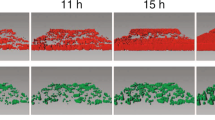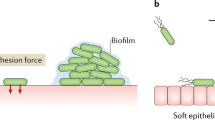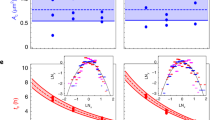Abstract
Bacteria use a chemical communication process called quorum sensing (QS) to control collective behaviours such as pathogenesis and biofilm formation1,2. QS relies on the production, release and group-wide detection of signal molecules called autoinducers. To date, studies of bacterial pathogenesis in well-mixed cultures have revealed virulence factors and the regulatory circuits controlling them, including the overarching role of QS3. Although flow is ubiquitous to nearly all living systems4, much less explored is how QS influences pathogenic traits in scenarios that mimic host environments, for example, under fluid flow and in complex geometries. Previous studies5–7 have shown that sufficiently strong flow represses QS. Nonetheless, it is not known how QS functions under constant or intermittent flow, how it varies within biofilms or as a function of position along a confined flow, or how surface topography (grooves, crevices, pores) influence QS-mediated communication. We explore these questions using two common pathogens, Staphylococcus aureus and Vibrio cholerae. We identify conditions where flow represses QS and other conditions where QS is activated despite flow, including characterizing geometric and topographic features that influence the QS response. Our studies highlight that, under flow, genetically identical cells do not exhibit phenotypic uniformity with respect to QS in space and time, leading to complex patterns of pathogenesis and colonization. Understanding the ramifications of spatially and temporally non-uniform QS responses in realistic environments will be crucial for successful deployment of synthetic pro- and anti-QS strategies.
This is a preview of subscription content, access via your institution
Access options
Subscribe to this journal
Receive 12 digital issues and online access to articles
$119.00 per year
only $9.92 per issue
Buy this article
- Purchase on Springer Link
- Instant access to full article PDF
Prices may be subject to local taxes which are calculated during checkout




Similar content being viewed by others
References
Bassler, B. L. & Losick, R. Bacterially speaking. Cell 125, 237–246 (2006).
Novick, R. P. & Geisinger, E. Quorum sensing in staphylococci. Annu. Rev. Gen. 42, 541–564 (2008).
Arvidson, S. & Tegmark, K. Regulation of virulence determinants in Staphylococcus aureus. Int. J. Med. Microbiol. 291, 159–170 (2001).
Persat, A. et al. The mechanical world of bacteria. Cell 161, 988–997 (2015).
Purevdorj, B., Costerton, J. W. & Stoodley, P. Influence of hydrodynamics and cell signaling on the structure and behavior of Pseudomonas aeruginosa biofilms. Appl. Environ. Microbiol. 68, 4457–4464 (2002).
Kirisits, M. J. et al. Influence of the hydrodynamic environment on quorum sensing in Pseudomonas aeruginosa biofilms. J. Bacteriol. 189, 8357–8360 (2007).
Meyer, A. et al. Dynamics of AHL mediated quorum sensing under flow and non-flow conditions. Phys. Biol. 9, 026007 (2012).
Rusconi, R., Garren, M. & Stocker, R. Microfluidics expanding the frontiers of microbial ecology. Annu. Rev. Biophys. 43, 65–91 (2014).
Fine, K. D., Santaana, C. A., Porter, J. L. & Fordtran, J. S. Effect of changing intestinal flow rate on a measurement of intestinal permeability. Gastroenterology 108, 983–989 (1995).
Lipowsky, H. H., Kovalcheck, S. & Zweifach, B. W. Distribution of blood rheological parameters in microvasculature of cat mesentery. Circ. Res. 43, 738–749 (1978).
Liese, J., Rooijakkers, S. H. M., van Strijp, J. A. G., Novick, R. P. & Dustin, M. L. Intravital two-photon microscopy of host–pathogen interactions in a mouse model of Staphylococcus aureus skin abscess formation. Cell. Microbiol. 15, 891–909 (2013).
Cheung, A. L., Nishina, K. & Manna, A. C. SarA of Staphylococcus aureus binds to the sarA promoter to regulate gene expression. J. Bacteriol. 190, 2239–2243 (2008).
Stewart, P. S. Mini-review: convection around biofilms. Biofouling 28, 187–198 (2012).
Weaver, W. M., Milisavljevic, V., Miller, J. F. & Di Carlo, D. Fluid flow induces biofilm formation in Staphylococcus epidermidis polysaccharide intracellular adhesin-positive clinical isolates. Appl. Environ. Microbiol. 78, 5890–5896 (2012).
Kim, M. K., Drescher, K., Pak, O. S., Bassler, B. L. & Stone, H. A. Filaments in curved streamlines: rapid formation of Staphylococcus aureus biofilm streamers. New J. Phys. 16, 065024 (2014).
Drescher, K., Shen, Y., Bassler, B. L. & Stone, H. A. Biofilm streamers cause catastrophic disruption of flow with consequences for environmental and medical systems. Proc. Natl Acad. Sci. USA 110, 4345–4350 (2013).
Drescher, K., Nadell, C. D., Stone, H. A., Wingreen, N. S. & Bassler, B. L. Solutions to the public goods dilemma in bacterial biofilms. Curr. Biol. 24, 50–55 (2014).
Horswill, A. R., Stoodley, P., Stewart, P. S. & Parsek, M. R. The effect of the chemical, biological, and physical environment on quorum sensing in structured microbial communities. Anal. Bioanal. Chem. 387, 371–380 (2007).
Stoodley, P., Debeer, D. & Lewandowski, Z. Liquid flow in biofilm systems. Appl. Environ. Microbiol. 60, 2711–2716 (1994).
Boles, B. R. & Horswill, A. R. agr-Mediated dispersal of Staphylococcus aureus biofilms. PLoS Pathogens 4, e1000052 (2008).
Periasamy, S. et al. How Staphylococcus aureus biofilms develop their characteristic structure. Proc. Natl Acad. Sci. USA 109, 1281–1286 (2012).
Yarwood, J. M., Bartels, D. J., Volper, E. M. & Greenberg, E. P. Quorum sensing in Staphylococcus aureus biofilms. J. Bacteriol. 186, 1838–1850 (2004).
Parsek, M. R. & Greenberg, E. P. Sociomicrobiology: the connections between quorum sensing and biofilms. Trends Microbiol. 13, 27–33 (2005).
Siryaporn, A., Kim, M. K., Shen, Y., Stone, H. A. & Gitai, Z. Colonization, competition, and dispersal of pathogens in fluid flow networks. Curr. Biol. 25, 1201–1207 (2015).
Acton, D. S., Plat-Sinnige, M. J. T., van Wamel, W., de Groot, N. & van Belkum, A. Intestinal carriage of Staphylococcus aureus: how does its frequency compare with that of nasal carriage and what is its clinical impact? Eur. J. Clin. Microbiol. Infect. Dis. 28, 115–127 (2009).
Pan, F. & Acrivos, A. Steady flows in rectangular cavities. J. Fluid Mech. 28, 643–655 (1967).
Benjamin, M. A., Lu, J., Donnelly, G., Dureja, P. & McKay, D. M. Changes in murine jejunal morphology evoked by the bacterial superantigen Staphylococcus aureus enterotoxin B are mediated by CD4+ T cells. Infect. Immun. 66, 2193–2199 (1998).
Millet, Y. A. et al. Insights into Vibrio cholerae intestinal colonization from monitoring fluorescently labeled bacteria. PLoS Pathogens 10, e1004405 (2014).
Zhao, X. A., Koestler, B. J., Waters, C. M. & Hammer, B. K. Post-transcriptional activation of a diguanylate cyclase by quorum sensing small RNAs promotes biofilm formation in Vibrio cholerae. Mol. Microbiol. 89, 989–1002 (2013).
George, E. A., Novick, R. P. & Muir, T. W. Cyclic peptide inhibitors of staphylococcal virulence prepared by Fmoc-based thiolactone peptide synthesis. J. Am. Chem. Soc. 130, 4914–4924 (2008).
Nadell, C. D. & Bassler, B. L. A fitness trade-off between local competition and dispersal in Vibrio cholerae biofilms. Proc. Natl Acad. Sci. USA 108, 14181–14185 (2011).
Bryksin, A. V. & Matsumura, I. Overlap extension PCR cloning: a simple and reliable way to create recombinant plasmids. Biotechniques 48, 463–465 (2010).
Malone, C. L. et al. Fluorescent reporters for Staphylococcus aureus. J. Microbiol. Methods 77, 251–260 (2009).
Gibson, D. G. et al. Enzymatic assembly of DNA molecules up to several hundred kilobases. Nature Methods 6, 343–U41 (2009).
Novick, R. P. Genetic systems in Staphylococci. Methods Enzymol. 204, 587–636 (1991).
Acknowledgements
The authors acknowledge the Novick Laboratory for providing S. aureus strains and the pJL-agr-GFP plasmid. The authors thank B. Wang, J. Chen, K. Papenfort and J. Yan for technical advice and discussions, and K. Drescher for discussions and for providing strain KDV028. The authors thank A. Ismail for providing the image that appears in Fig. 4a,i and W. Lee for the image in Fig. 4a,ii. The authors thank members of the B.L.B. and H.A.S. laboratories for suggestions. This work was supported by National Science Foundation grants MCB-1119232 (B.L.B. and H.A.S.) and MCB-1344191 (B.L.B. and H.A.S), the Howard Hughes Medical Institute (B.L.B.), National Institutes of Health grant R01GM065859 (B.L.B.) and an STX fellowship (M.K.K.).
Author information
Authors and Affiliations
Contributions
M.K.K., F.I., B.L.B. and H.A.S. designed the experiments. M.K.K. and F.I. performed the experiments. A.Z. synthesized the AIP. F.I. constructed the quantitative model and H.A.S. revised it. M.K.K., F.I., B.L.B. and H.A.S. analysed the data and wrote the manuscript. All authors discussed and approved the results.
Corresponding authors
Ethics declarations
Competing interests
The authors declare no competing financial interests.
Supplementary information
Supplementary Information
Supplementary Figures 1–8, Tables 1–3, Equations, Methods and References. (PDF 2444 kb)
Supplementary Video 1
Fluid flows locally repress QS by advecting signalling molecules. Time series of merged fluorescence images of S. aureus under no flow and flow conditions for 12 h after inoculation (see Fig. 1b for details). The time interval between each image is 10 min. (AVI 5172 kb)
Supplementary Video 2
Forming a thick biofilm promotes QS under flow. Series of merged fluorescence images of S. aureus biofilms for the xy planes as a function of z-axis. The same biofilm region is taken under flow for 13 h after inoculation (left) and following 13 h of flow and 3 h of no flow (right). The interval between each frame is 3 µm in z-axis. (AVI 1639 kb)
Supplementary Video 3
Flows assist long-distance QS by enhancing autoinducer accumulation. Time series of merged images of S. aureus under a constant flow at different downstream locations along a microfluidic channel (Q[fluid] = 0.5 µl per min): from left to right in the video, indicating 50 mm, 240 mm, 280 mm and 300 mm from the inlet, respectively. The time interval between each image is 20 min. (AVI 3022 kb)
Supplementary Video 4
QS is activated inside crevices. Time series of merged fluorescence images of S. aureus in a complex topography. The time interval between each image is 10 min (AVI 5327 kb)
Supplementary Video 5
QS dynamics of S. aureus MRSA in a complex topography with continuous injection of 1 µM antagonist (AIP-II). Time series of merged fluorescence images of S. aureus MRSA inside of crevices in the absence of antagonist (right) and when 1 µM antagonist (AIP-II; left) was continuously flowed into the channel beginning 16 h after inoculation. The time interval between each image is 20 min. (AVI 4509 kb)
Rights and permissions
About this article
Cite this article
Kim, M., Ingremeau, F., Zhao, A. et al. Local and global consequences of flow on bacterial quorum sensing. Nat Microbiol 1, 15005 (2016). https://doi.org/10.1038/nmicrobiol.2015.5
Received:
Accepted:
Published:
DOI: https://doi.org/10.1038/nmicrobiol.2015.5
This article is cited by
-
Bacterial quorum sensing orchestrates longitudinal interactions to shape microbiota assembly
Microbiome (2023)
-
Controlling pore-scale processes to tame subsurface biomineralization
Reviews in Environmental Science and Bio/Technology (2022)
-
The effect of flow on swimming bacteria controls the initial colonization of curved surfaces
Nature Communications (2020)
-
Collective intercellular communication through ultra-fast hydrodynamic trigger waves
Nature (2019)
-
Enhanced propagation of motile bacteria on surfaces due to forward scattering
Nature Communications (2019)



